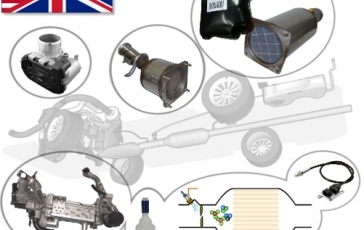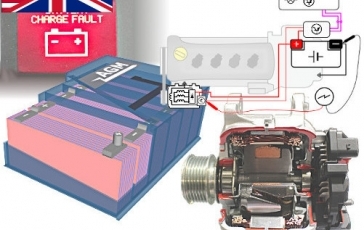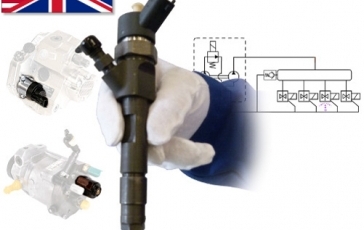-

Diesel exhaust gas technology is full of abbreviations. What do you know about EGR, DPF, SCR, etc? Learn everything you need to know about these technologies and become an expert in the field with this online training module. Learn how the systems work, and how to diagnose them in case of a possible fault. Learn the right ways of repairing and servicing these systems with this online training module for mechanics.
- Exhaust gas components and systems
- Exhaust Gas Recirculation (EGR) from vacuum
- Controlled valve to dual circulation systems
- Cooling of exhaust gases and circulation boosting
- EGR control principles and repairs
- After treatment components
- Particle filter systems and their regeneration
- SCR catalysts and how they operate
- After treatment malfunctions, service and repairs
€ 38 -

Brake service and repair is probably one of the most common additional jobs that are linked in connection to the interval service. Every mechanic has to master the basics of brake servicing and be able to perform it on different brake system structures, be this an older passenger car or a new electric car.
- Recognising different structures and components, and knowing how they function
- Assessing the need for service and repair
- Front- and rear brake service
- Drum brake service
- Attending to electric- and mechanical parking brakes
- Brake cylinder inspection and service
- Bleeding the brake fluid circuit correctly
- Changing the brake fluid
€ 48 -

The vehicle’s electrical systems are all interconnected via electric power management, i.e. through the battery and charging system. Checking the battery and the charging system’s condition is always the starting point for all troubleshooting in other electrical systems.
- Inspection of the charging system.
- Examples of measurement results and analysis.
- Alternator structure and operation.
- Alternator control circuits and operation types.
- Checking the starter battery using various methods.
- Structure and operation of starter batteries.
- Battery chargers. Highlight of battery replacement.
€ 34 -

This online training module in common rail technology takes you through the systems function and construction. It presents to you the common rail direct injection advantages, and teaches you the basics of common rail troubleshooting and diagnostics. Learn more with this online training module, and become a diesel injection expert.
- Timing of injection and conditions for starting the engine
- Developments in European emission standards and diesel fuel
- Low-pressure system components
- High-pressure system components
- Injection pressure adjustment
- Troubleshooting issues with fuel flow and pressure
- Troubleshooting component faults
€ 44 -

32In this study module we repeat the basic overview of electrical engineering and have added information on the use of a multimeter for you to learn. With the know-how from this module, you can apply electrical engineering skills in the first practical tasks.
- How electricity is generated and how its phenomena can be utilised
- Electrical engineering in a generator, actuator and detector
- The multimeter and basic measurements
- Utilisation of the multimeter and making use of a power clamp
- The practical application of multimeter measurements
- Studying and applying electrical engineering variables
- Practical application of power and voltage laws
- Practical application of measurement results and basic laws of electrical engineering
€ 32 -

Electronics and electrical components are a central part of electric circuits. Resistors, diodes, leds, thyristors, transistors and microcircuits can be found almost everywhere in a vehicle. A mechanic has to understand the function of the components and circuits, to be able to perform troubleshooting.
- Electronics basics
- Component properties
- Integrated and programmable circuits
- Common electronic components and their functions
- Voltage divider circuits
- Voltage stabilising in electronics
- Rectifying alternating current
- Amplification circuits
- Delay and timer circuits
€ 24 -

If you want to develop your own diagnostic skills and perform diagnostics, you will need to know the structure and function of EOBD/OBD-II Self-Diagnostics. This training module is for you if you want to make the most effective use of OBD-standard diagnostics. You will learn a lot of new things even if manufacturer’s OEM diagnostics is already familiar to you.
- Basics of self-diagnostics, component and functional diagnostics.
- Malfunction indicator lights and diagnostic trouble codes.
- Diagnostic functions of OBD and OEM diagnostics.
- Use of EOBD/OBD-II diagnostics.
- Operating modes and PID codes.
- Drive cycles and trips.
- Utilising component diagnostics.
- Partial tests requiring constant monitoring and their utilisation.
- Partial tests requiring periodic monitoring and their utilisation.
€ 34 -

Learn the basics behind the 2014 Toyota Prius PHEV with this online training module. Learn what you need to know about the construction of the vehicle, and how to find the recent manufacturer instructions for servicing and repairing the vehicle.
- General presentation and features of the HV Toyota
- Prius PHEV 2014
- High-Voltage Systems
- Special usage and driving features
- Structure and description of the high-voltage system
- Functions of the high voltage system in different operating conditions
- The material corresponds to the technology for Toyota Prius model year 2014
€ 22 -

Hybrid and electric vehicles are here to stay and mechanics need to acquire new skills. Luckily Prodiags can help you with easy-to-use professional online training module you can use anytime and anywhere. Try our Hybrid and Electric Vehicle Technology Online Training Module to learn how the hybrid and electric vehicles work.
- General Hybrid and Electric Vehicle Technology
- High-Voltage Systems
- Driving and Charging
- Maintenance and Faults
- Electric Shocks, Accidents and First Aid
- Collision Damage
- Battery Chemicals and Magnetism
- Safety Requirements in the Workshop
- Personal Protective Equipment and Hand Tools
- Measuring and Testing Equipment
- De-energising the vehicle
€ 38 -

If you are involved in class B driving instruction, giving a young person driving lessons, and you would like to learn how to maintain your vehicle in a good condition and avoid future problems, you are interested in cars or you are new student in the automotive sector, this training module has been developed for you to achieve these goals.
- Observations when approaching the vehicle
- Checks outside, inside the vehicle, in the engine compartment, and also observations during driving such as noises
- Daily items and practical tips
- Weekly checks, e.g. tyres and pressures
- Monthly and inspections before long trips, liquid levels and adding liquids
- VW Golf, year model 2015, as an example
- Practical tips from a professional to the user
€ 28 -

Understanding the Starter System’s function and control circuit is essential for a mechanic when troubleshooting a vehicle that won’t start. Newer vehicles also has a Start-Stop function, which reduces emissions and noise.
- Check the starter circuit in a correct way
- Inspection measurements example with images
- Measurement analysis and condition assessment
- Typical starter motors, parts and function
- Control circuits and operation
- Start-Stop system, operation and use
€ 34 -

Do you know the difference between indirect tire pressure monitoring systems and direct tire pressure monitoring systems? Do you know where to begin the troubleshooting if a customer complains about TPMS malfunctions? Learn this and much more in this Online Training Module about TPMS.
- The Basics of Tyre Pressure and Tyre Pressure
- Monitoring Systems (TPMS)
- Direct Tyre Pressure Monitoring
- Indirect Tyre Pressure Monitoring
- Components
- Operating Principles
- Pressure Transmitter Repairs
- Impact on Tyre Work
€ 32 -

When working on the vehicle’s tyres and carrying out seasonal changing of tyres, you need to know the technical characteristics of tyres and wheel rims. You need to be in possession of proper inspection and mounting/dismounting skills, and you need to be able to advise the customer in safe operation and follow-up procedures. The vehicle’s tyres and wheel rims will give trouble-free service when the tyre and rim condition is attended to by a properly trained tyre-and-wheel professional.
- Tyre characteristics and requirements
- Rim characteristics and requirements
- Inspection of tyres and rims
- Correct and safe wheel/tyre changing
- Working on tyres Wheel balancing
€ 36 -

The study of occupational safety in the automotive sector is aimed specifically at new car workers and students. Introducing occupational safety to industry-specific objects and special requirements makes studying truly effective and meaningful even if you don’t have years of work experience.
- General industry requirements for workshops and staff
- Work position and lifting suitable for the work situation
- Warehouses and washrooms
- Handling of combustible materials and operation in case of fire
- Mechanic’s workwear and workstation
- Working with power tools
- Accident site and emergency notification
- Identifying different types of accidents and basics of first aid
- Starting a resuscitation
€ 16 -

The maintenance workshop and the brands it represents should treat the recycling of waste and working in an environmental way as a very important aspect of its business. Success in sorting and recycling is only as good as the skills of the lowest skilled staff. As a result, at the individual level, the expertise in sorting and recycling garage waste is key to operations. Waste sorting and recycling also has strong economic grounds.
- Basics of sorting at waste stations.
- Identification and sorting of service waste.
- Identification and sorting of waste generated by repairs.
€ 28 -

Checking the function and operational preconditions of an electrical component is applying electrical engineering knowledge at its finest. In addition to electrical engineering you should be able to “read” electrical circuit diagrams and perform measurements with the correct equipment. Being successful in the troubleshooting requires, amongst other things, proper use and understanding of the oscilloscope.
- Electrical Circuit Diagrams and Markings
- Oscilloscope Operating Principle and Connections
- Settings, Accuracy and Measuring Probes
- Electrical Operational Preconditions of a Component
- Checking the Operational Preconditions
- Short Circuit Troubleshooting
- Battery Discharge Current Troubleshooting
€ 44
E-learning Courses
Practical Courses
Practical training is an ideal way to put your theory from our e-learning modules in to a real workshop situation. you can book a one or two day course at the level and subject that you wish to pursue. we use proffesional engine rigs and complete cars along with diagnostic equipment, multimeters, scopemeters and assorted testing products.



















